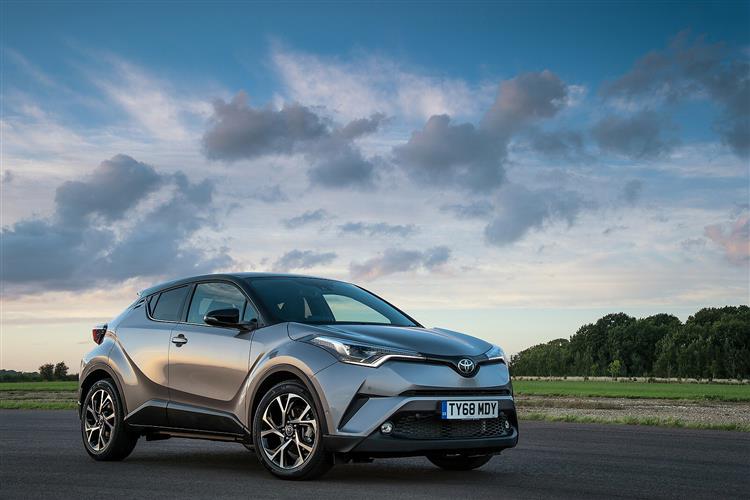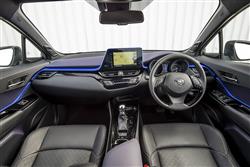How will you view?
This is a sample, and will stop after 30 seconds.
NOT SO PALE RIDER (some text hidden) SECTIONED_new_toyotac-hr_2017
By Jonathan Crouch
Introductionword count: 70
Crossovers are ever-more crucial for the mainstream makers and this one, the C-HR (the letters standing for 'Coupe-High Rider'), turned out to be particularly important for Toyota. The styling's a little extreme, but then it was supposed to be, aimed at Qashqai-class buyers who wanted to make something of a statement. This car certainly does that. But does it makes sense in its original 2016-2019-era form as a used buy?
Modelsword count: 11
5 door SUV (1.2, 1.8 Hybrid - petrol) [Icon, Excel, Dynamic]
Historyword count: 300
What comes to mind when you think of a Toyota? Back at the end of 2016, it wasn't anything like what was served up by the brand's C-HR small Crossover. This model took people's pre-conceptions about the brand - and then stamped all over them. Back in 1994, another similarly-sized and targeted Toyota also did exactly that, the original RAV4 as dramatic a departure for the brand in its time as this C-HR - or 'Coupe-High Rider' - model was at its launch in December 2016. Back then, the innovation didn't last and the RAV4 became boring and middle-aged at a time when it could have become the kind of fashionable 'Qashqai-class' Crossover that buyers would have loved. It could have become, well, something exactly like this C-HR. So what, precisely, is on offer here? A credible rival at last to the strong-selling Nissan Juke? Certain styling similarities combine with the flamboyant panelwork to suggest that at first glance. Take a second look though and it becomes clear that this is a slightly larger, more sophisticated piece of design, more or less the size of a family-shaped Qashqai. Plus inside, the C-HR promises a more interesting, higher-quality cabin than you might expect to find from this era in this segment. The innovation continues beneath the bonnet too, with petrol/electric hybrid power offered as an alternative to a conventional petrol unit and no sign of the kind of diesel powerplant that buyers in this class sometimes prioritise. A forward-thinking contender then - in more ways than one. Let's put it to the test. The C-HR in its original form lasted until late 2019, when a facelifted version was introduced which offered the option of a larger 2.0-litre Hybrid engine. It's the original pre-facelift models we're going to look at here though.
What You Getword count: 381
Just look at it. Can this really be a model made by Toyota, a brand so notable for forgettably-styled family hatchbacks? See a C-HR for the first time and it's difficult to know what to look at first, with prominently projecting wheel arches, hidden rear door handles and a floating roof headlining the design flourishes. If you accept that the finished product is part-coupe, part-hatchback and part-Crossover, then without doubt it's the SUV element that's most obvious at the front, the high bonnet framing a slender upper grille and headlights smeared at each corner. In profile, the coupe cues become more obvious, with an evident sense of movement, even at a standstill, thanks to a dramatic upward centre crease that rises sharply into the power-packed rear haunches. And behind the wheel? Well it would have been such a disappointment if all that exterior innovation had been matched with interior design derived from a Yaris or an Auris. Thankfully, that's not the case. Instead, Toyota serves up diamond-themed door cards, stereo speakers shaped like Ninja weapons, an eye-catching 'deco line' trim strip that runs from side to side of the cabin and an intricately-layered fascia topped off by an asymmetrically-shaped infotainment screen that's ferociously unconventional and looks like it's crash-landed in the middle of the dash. Almost equally surprising for anyone familiar with typical Toyota interior design is the quality of the materials used. There are certainly plenty of them, nappa-grained soft-touch plastic juxtaposed with piano black lacquers, fake carbon-fibre and satin chrome. The men in polo-necks really went to town here. When it's time to take a seat in the rear though, you initially fear that the whole C-HR experience might start to unravel. Well it is what it is. Given the limitations of the stylised shape though, we reckon the designers did pretty well here, though it's true that the cabin space in the back is generally more akin to that you'd get in Crossover with smaller outward dimensions. As for the boot, well here again, the swept-back rear styling might lead you to worry when it comes to issues of sense and sensibility. Lift the tailgate and there's quite a high loading lip, but once you get beyond it, there's a reasonably-shaped if rather shallow space, 377-litres in size.
To see the full road test text contact us on 0330 0020 227
Pictures (high res disabled)

.jpg)
|
.jpg)
|
.jpg)
| |||
.jpg)
|
.jpg)
|
.jpg)
| |||
.jpg)
|
.jpg)
|

|
Scoring (subset of scores)
Category: Crossover or SUV 4x4s
| Performance | |
| Handling | |
| Comfort | |
| Space | |
| Styling, Build, Value, Equipment, Depreciation, Handling, Insurance and Total scores are available with our full data feed. | |



